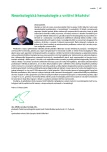Differential diagnosis of anemia
Authors:
Jan Válka; Jaroslav Čermák
Authors‘ workplace:
Ústav hematologie a krevní transfuze, Praha
Published in:
Vnitř Lék 2018; 64(5): 468-475
Category:
Overview
Anemia, defined as hemoglobin level under lower normal limit, is a symptom of different pathologic conditions and the accurate differential diagnosis is necessary to determine the cause of anemia. The article uses the morphological classification of anemia to distinguish macrocytic, normocytic and microcytic types of anemias and divides anemias with increased amount of peripheral blood reticulocytes as a special group. It describes commonly known clinical units as iron deficiency anemia or anemia of chronic disease, as so as rare clinical units, which are always need to think about in a differential diagnosis of an anemic patient. There is an increasing incidence of rare blood disorders due to introduction of molecular genetics methods into diagnostics, prolonged overall survival of patients and increasing migration from areas with endemic occurrence of these diseases. Etiology, basic pathophysiological mechanisms, main clinical features together with important diagnostic examinations are described by each clinical unit. Due to the differential diagnostic focus of the article only basic knowledge about therapy is mentioned. The authors are members of the IHBT Center for Rare Disorders of Hematopoiesis, which is focused mainly on congenital and acquired disorders of red blood cell.
Key words:
anemia – differential diagnosis – enzymopathies – hemoglobinopathies – iron – macrocytosis – microcytosis – rare blood disorders – reticulocytosis
Sources
- Buliková A. Anémie. In: Penka M, Buliková A et al. Neonkologická hematologie. 2. ed. Grada: Praha 2009: 39–95. ISBN 978–80–247–2299–3.
- Vydra J, Čermák J. Anémie. In: Vydra J, Cetkovský P (eds) et al. Hematologie v kostce. Mladá fronta: Praha 2015: 11–68. ISBN 978–80–204–3698–6.
- Camaschella C. Iron-deficiency anemia. N Engl J Med 2015; 372(19): 1832–1843. Dostupné z DOI: <http://dx.doi.org/10.1056/NEJMra1401038>.
- Nemeth E, Ganz T. Anemia of Inflammation. Hematol Oncol Clin N Am 2014; 28(4): 671–681, vi. Dostupné z DOI: <http://dx.doi.org/10.1016/j.hoc.2014.04.005>.
- Rund D, Rachmilewitz E. β thalassemia. N Engl J Med 2005; 353(11): 1135–1146. Dostupné z DOI: <http://dx.doi.org/10.1056/NEJMra050436>.
- Divoka M, Partschova M, Kucerova J et al. Molecular characteristics of β-thalassemia in the Czech and Slovak populations: Mediterranean, Asian and unique mutations. Hemoglobin 2016; 40(3): 156–162. Dostupné z DOI: <http://dx.doi.org/10.3109/03630269.2016.1152581>.
- Harteveld CR, Higgs CR. α-thalassemia. Orphanet J Rare Dis 2010; 5: 13. Dostupné z DOI: <http://dx.doi.org/10.1186/1750–1172–5-13>.
- Čermák J. K diferenciální diagnostice a léčbě anémií. Remedia 2003; 13(4): 258–265.
- Bizzaro N, Antico A. Diagnosis and classification of pernicious anemia. Autoimmun Rev 2014; 13(4–5): 565–568. Dostupné z DOI: <http://dx.doi.org/10.1016/j.autrev.2014.01.042>.
- Papaemmanuil E, Gerstung M, Malcovati L et al. Clinical and biological implications of driver mutations in myelodysplastic syndromes. Blood 2013; 122(22): 3616–3627. Dostupné z DOI: <http://dx.doi.org/10.1182/blood-2013–08–518886>.
- Vlachos A, Ball S, Dahl N et al. Diagnosing and treating Diamond Blackfan anaemia: results of an international clinical consensus conference. Br J Haematol 2008; 142(6): 859–876. Dostupné z DOI: <http://dx.doi.org/10.1111/j.1365–2141.2008.07269.x>.
- Shimamura A, Alter BP. Pathophysiology and management of inherited bone marrow failure syndromes. Blood Rev 2010; 24(3): 101–122. Dostupné z DOI: <http://dx.doi.org/10.1016/j.blre.2010.03.002>. Erratum in Blood Rev 2010; 24(4–5): 201.
- Young NS, Maciejewski J. The pathophysiology of acquired aplastic anemia. N Engl J Med 1997; 336(19): 1365–1372. Dostupné z DOI: <http://dx.doi.org/10.1056/NEJM199705083361906>.
- Čermák J. Myelodysplastický syndrom. In: Starý J, Mayer J (eds). Leukémie. Grada: Praha 2002: 221–234. ISBN 80–7169–991–8.
- D´Andrea AD, Grompe M. Molecular Biology of Fanconi Anemia: Implications for Diagnosis and Therapy. Blood 1997; 90(5): 1725–1736.
- Bolton-Maggs PHB, Langer JC, Iolascon A et al. Guidelines for the diagnosis and management of hereditary spherocytosis – 2011 update. Br J Haematol 2004; 156(1): 37–49. Dostupné z DOI: <http://dx.doi.org/10.1111/j.1365–2141.2011.08921.x>.
- Grace RF, Zanella A, Neufeld EJ et al. Erythrocyte pyruvate kinase deficiency: 2015 status report. Am J Hematol 2015; 90(9): 825–830. Dostupné z DOI: <http://dx.doi.org/10.1002/ajh.24088>.
- Beutler E. Glucose-6-phosphate dehydrogenase deficiency: a historical perspective. Blood 2008; 111(1): 16–24. <http://dx.doi.org/10.1182/blood-2007–04–077412>.
- Stuart MJ, Nagel RL. Sickle cell disease. Lancet 2004; 364(9442): 1343–1360. Dostupné z DOI: <http://dx.doi.org/10.1016/S0140–6736(04)17192–4>.
- Zanella A, Barcellini W. Treatment of autoimmune hemolytic anemias. Haematologica 2014; 99(10): 1547–1554. Dostupné z DOI: <http://dx.doi.org/10.3324/haematol.2014.114561>.
- Válka J. Paroxysmální noční hemoglobinurie pro praktické lékaře. XIV. kongres praktických lékařů v Praze – abstract. Med Praxi 2017; 14(Suppl E): 11.
Labels
Diabetology Endocrinology Internal medicineArticle was published in
Internal Medicine

2018 Issue 5
Most read in this issue
- Autoimmune hemolytic anemia
- Differential diagnosis of anemia
- Congenital and acquired bleeding disorders
- Hemoglobinopathies
